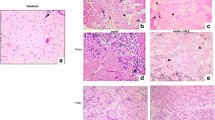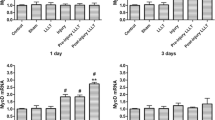Abstract
Skeletal muscle myopathy is a common source of disability in diabetic patients. This study evaluated whether low-level laser therapy (LLLT) influences the healing morphology of injured skeletal muscle. Sixty-five male Wistar rats were divided as follows: (1) sham; (2) control; (3) diabetic; (4) diabetic sham; (5) nondiabetic cryoinjured submitted to LLLT (LLLT); (6) diabetic cryoinjured submitted to LLLT (D-LLLT); and (7) diabetic cryoinjured non-treated (D). Diabetes was induced with streptozotocin. Anterior tibialis muscle was cryoinjured and received LLLT daily (780 nm, 5 J/cm2, 10 s per point; 0.2 J; total treatment, 1.6 J). Euthanasia occurred on day 1 in groups 1, 2, 3, and 4 and on days 1, 7, and 14 in groups 5, 6, and 7. Muscle samples were processed for H&E and Picrosirius Red and photographed. Leukocytes, myonecrosis, fibrosis, and immature fibers were manually quantified using the ImageJ software. On day 1, all cryoinjured groups were in the inflammatory phase. The D group exhibited more myonecrosis than LLLT group (p < 0.05). On day 14, the LLLT group was in the remodeling phase; the D group was still in the proliferative phase, with fibrosis, chronic inflammation, and granulation tissue; and the D-LLLT group was in an intermediary state in relation to the two previous groups. Under polarized light, on day 14, the LLLT and D-LLLT groups had organized collagen bundles in the perimysium, whereas the diabetic groups exhibited fibrosis. LLLT can have a positive effect on the morphology of skeletal muscle during the tissue repair process by enhancing the reorganization of myofibers and the perimysium, reducing fibrosis.





Similar content being viewed by others
References
Wild S, Roglic G, Green A, Sicree R, King H (2004) Global prevalence of diabetes. Estimates for the year 2000 and projections for 2030. Diabetes Care 27:1047–1053
Howard AC, McNeil AK, Xiong F, Xiong WC, McNeil PL (2011) A novel cellular defect in diabetes: membrane repair failure. Diabetes 60:3034–3043
Tidball JG, Villalta SA (2010) Regulatory interactions between muscle and the immune system during muscle regeneration. Am J Physiol Regul Integr Comp Physiol 298:R1173–R1187
van der Poel C, Gosselin LE, Schertzer JD, Ryall JG, Swiderski K, Wondemaghen M, Lynch GS (2011) Ageing prolongs inflammatory marker expression in regenerating rat skeletal muscles after injury. J Inflamm (Lond) 8:41
Dogra C, Hall SL, Wedhas N, Linkhart TA, Kumar A (2007) Fibroblast growth factor inducible-14 (Fn14) is required for the expression of myogenic regulatory factors and differentiation of myoblasts into myotubes: evidence for TWEAK-independent functions of Fn14 during myogenesis. J Biol Chem 282:15000–15010
Hawke TJ, Garry DJ (2001) Myogenic satellite cells: physiology to molecular biology. J Appl Physiol 91:534–551
Al-Watban FA (2009) Laser therapy converts diabetic wound healing to normal healing. Photomed Laser Surg 27:127–135
Fulop AM, Dhimmer S, Deluca JR, Johanson DD, Lenz RV, Patel KB, Douris PC, Enwemeka CS (2009) A meta-analysis of the efficacy of phototherapy in tissue repair. Photomed Laser Surg 27:695–702
Kaviani A, Djavid GE, Ataie-Fashtami L, Fateh M, Ghodsi M, Salami M, Zand N, Kashef N, Larijani B (2011) A randomized clinical trial on the effect of low-level laser therapy on chronic diabetic foot wound healing: a preliminary report. Photomed Laser Surg 29:109–114
de Souza TO, Mesquita DA, Ferrari RA, Dos Santos Pinto D Jr, Correa L, Bussadori SK, Fernandes KP, Martins MD (2011) Phototherapy with low-level laser affects the remodeling of types I and III collagen in skeletal muscle repair. Lasers Med Sci 26:803–814
Mesquita-Ferrari RA, Martins MD, Silva JA Jr, da Silva TD, Piovesan RF, Pavesi VC, Bussadori SK, Fernandes KP (2011) Effects of low-level laser therapy on expression of TNF-α and TGF-β in skeletal muscle during the repair process. Lasers Med Sci 26(3):335–340
Baptista J, Martins MD, Pavesi VC, Bussadori SK, Fernandes KP, Pinto Júnior D dos S, Ferrari RA (2011) Influence of laser photobiomodulation on collagen IV during skeletal muscle tissue remodeling after injury in rats. Photomed Laser Surg 29:11–17
Miyabara EH, Martin JL, Griffin TM, Moriscot AS, Mestril R (2006) Overexpression of inducible 70-kDa heat shock protein in mouse attenuates skeletal muscle damage induced by cryolesioning. Am J Physiol Cell Physiol 290:C1128
Junqueira LC, Montes GS, Sanchez EM (1982) The influence of tissue section thickness on the study of collagen by the Picrosirius-polarization method. Histochemistry 74:153–156
Tang M, Zhou F, Zhang W, Guo Z, Shang Y, Lu H, Lu R, Zhang Y, Chen Y, Zhong M (2011) The role of thrombospondin-1-mediated TGF-β1 on collagen type III synthesis induced by high glucose. Mol Cell Biochem 346:49–56
Fukushima K, Badlani N, Usas A, Riano F, Fu FH, Huard J (2001) The use of an antifibrosis agent to improve muscle recovery after laceration. Am J Sports Med 29:394–402
Li Y, Foster W, Deasy BM, Chan Y, Prisk V, Tang Y, Cummins J, Huard J (2004) Transforming growth factor-beta1 induces the differentiation of myogenic cells into fibrotic cells in injured skeletal muscle: a key event in muscle fibrogenesis. Am J Pathol 164:1007–1019
Wieteska-Skrzeczynska W, Grzelkowska-Kowalczyk K, Jank M, Maciejewski H (2009) Transcriptional dysregulation of skeletal muscle protein metabolism in streptozotocin-diabetic mice. J Phisiol Pharmacol suppl 1:29–36
Acknowledgments
This study was supported by the Fundação de Amparo à Pesquisa do Estado de São Paulo (grants: 2011/20867-3; 2011/17638-2; and 2011/04452-8). The authors thank Fabiana dos Santos, Carina Aparecida dos Santos, and Daniela dal Molin Pissutti for their valuable technical assistance during the experimental procedures.
Conflict of interest
The authors declare no conflicts of interest related to this study.
Author information
Authors and Affiliations
Corresponding author
Rights and permissions
About this article
Cite this article
França, C.M., de Loura Santana, C., Takahashi, C.B. et al. Effect of laser therapy on skeletal muscle repair process in diabetic rats. Lasers Med Sci 28, 1331–1338 (2013). https://doi.org/10.1007/s10103-012-1249-2
Received:
Accepted:
Published:
Issue Date:
DOI: https://doi.org/10.1007/s10103-012-1249-2




